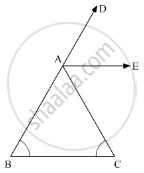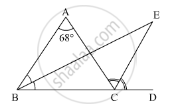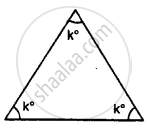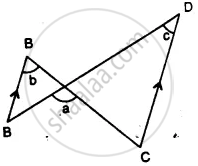Advertisements
Advertisements
Question
Can we have two acute angles whose sum is a reflex angle? Why or why not?
Solution
No, the sum of two acute angles is always less than 180°. So, their sum cannot be a reflex angle.
APPEARS IN
RELATED QUESTIONS
ABC is a triangle in which ∠A — 72°, the internal bisectors of angles B and C meet in O.
Find the magnitude of ∠BOC.
In the given figure, AE bisects ∠CAD and ∠B= ∠C. Prove that AE || BC.

In the given figure, side BC of ΔABC is produced to point D such that bisectors of ∠ABC and ∠ACD meet at a point E. If ∠BAC = 68°, find ∠BEC.

Side BC of a triangle ABC has been produced to a point D such that ∠ACD = 120°. If ∠B = \[\frac{1}{2}\]∠A is equal to
Find the unknown marked angles in the given figure:

In the given figure, show that: ∠a = ∠b + ∠c

(i) If ∠b = 60° and ∠c = 50° ; find ∠a.
(ii) If ∠a = 100° and ∠b = 55° : find ∠c.
(iii) If ∠a = 108° and ∠c = 48° ; find ∠b.
One of the base angles of an isosceles triangle is 52°. Find its angle of the vertex.
In the given figure, AB is parallel to CD. Then the value of b is
Q is a point on the side SR of a ∆PSR such that PQ = PR. Prove that PS > PQ.
Prove that in a triangle, other than an equilateral triangle, angle opposite the longest side is greater than `2/3` of a right angle.
